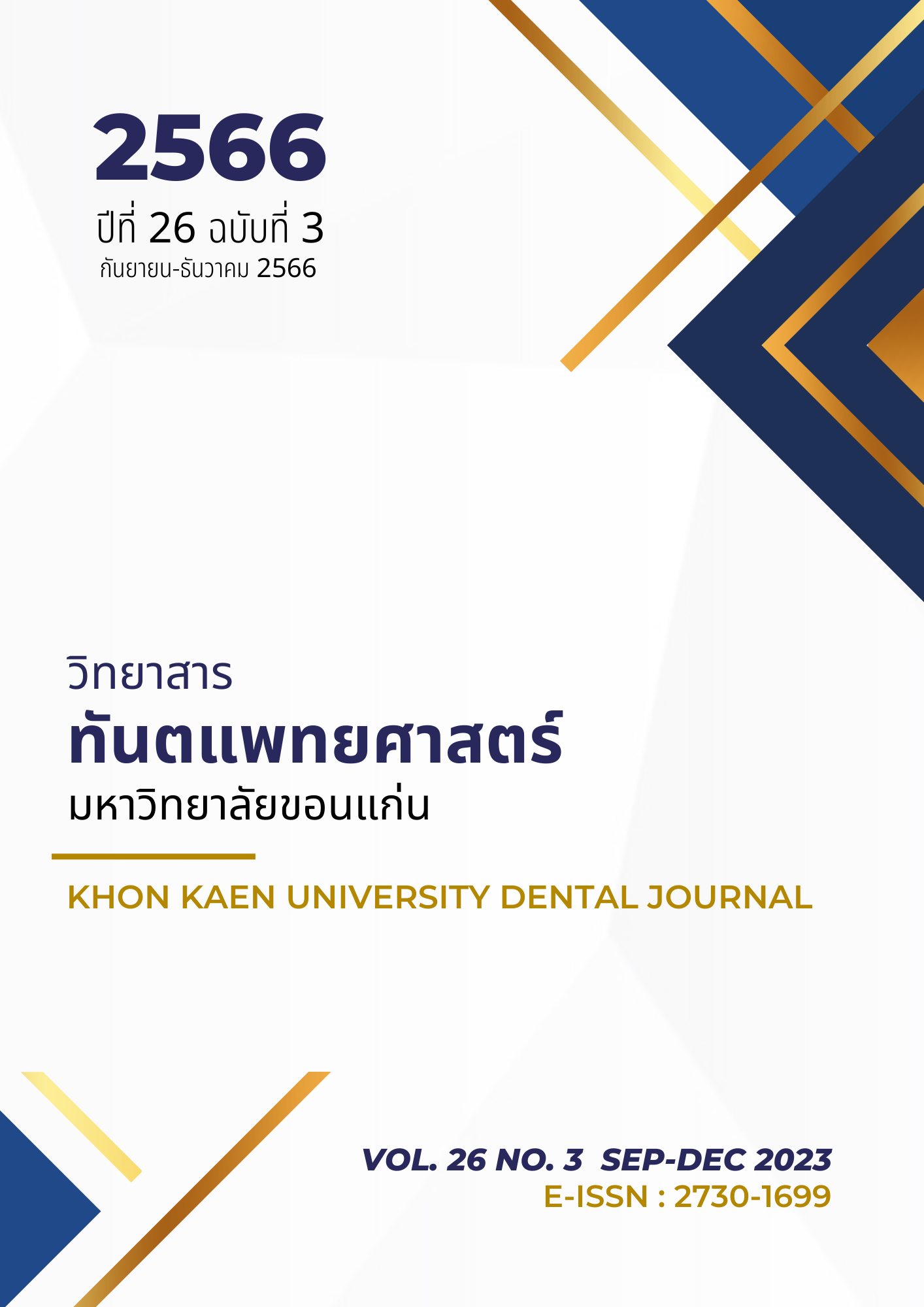การเปรียบเทียบประสิทธิภาพของเครื่องกรองอากาศแบบตั้งพื้นกับเครื่องกรองอากาศแบบติดเพดานในการลดปริมาณละอองฝอยในคลินิกทันตกรรมแบบเปิด
Main Article Content
บทคัดย่อ
การศึกษานี้มีจุดมุ่งหมายเพื่อวัดจำนวนละอองฝอยที่เกิดจากกระบวนการทางทันตกรรมในคลินิกทันตกรรมแบบเปิดภายใต้สภาวะแบบต่างๆ การศึกษานี้จัดรูปแบบที่แตกต่างกัน 3 แบบ ได้แก่ แบบที่ 1 ไม่ใช้เครื่องกรองอากาศ แบบที่ 2 ใช้เครื่องกรองอากาศแบบแขวนเพดาน และแบบที่ 3 ใช้เครื่องกรองอากาศแบบตั้งพื้น ในการทดสอบจะใช้ยูนิตทำฟันจำนวน 6 ยูนิต ซึ่งติดตั้งเป็นกลุ่มในพื้นที่เดียวกัน (เบย์) ภายในคลินิกทันตกรรมแบบเปิด แต่ละยูนิตทำฟันประกอบด้วยหัวหุ่นจำลอง ทำการกรอฟันซี่กลางบนด้านขวาเป็นลักษณะโพรงฟันแบบคลาสทรี ตรวจนับจำนวนละอองฝอยขนาด 0.5 ไมครอน และ 1.0 ไมครอน ด้วยเครื่องนับอนุภาค Aerocet 531s โดยนับจำนวนละอองฝอย 4 ตำแหน่งโดยรอบเบย์ บันทึกจำนวนละอองฝอยทั้งหมด 6 ครั้ง โดยครั้งแรกก่อนเริ่มกรอฟัน และระหว่างกรอฟันนาทีที่ 1 5 10 ทั้งนี้เมื่อกรอฟันครบ 10 นาทีแล้ว หยุดกรอและวัดต่อที่นาทีที่ 15 และ 20 นำค่าที่วัดได้มาทดสอบทางสถิติเพื่อเปรียบเทียบจำนวนละอองฝอยในกลุ่มต่าง ๆ ของแต่ละช่วงเวลาด้วยวิธีการวิเคราะห์ความแปรปรวนแบบทางเดียว และ เปรียบเทียบจำนวนละอองฝอยในการทดสอบแบบเดียวกันในช่วงเวลาต่าง ๆ ด้วยวิธีการวิเคราะห์ความแปรปรวนทางเดียวแบบวัดซ้ำ ผลการทดสอบทางสถิติแสดงให้เห็นว่าการใช้เครื่องกรองอากาศแบบตั้งพื้นสามารถช่วยลดจำนวนละอองฝอยรอบเบย์ในคลินิกทันตกรรมแบบเปิดได้อย่างมีนัยสำคัญเมื่อเปรียบเทียบกับการไม่ใช้เครื่องกรองอากาศในนาทีที่ 1 5 10 15 และ 20 อีกทั้งการใช้เครื่องกรองอากาศแบบตั้งพื้นยังสามารถช่วยลดจำนวนละอองฝอยได้มากกว่าเครื่องกรองอากาศแบบติดเพดานอย่างมีนัยสำคัญในบางช่วงเวลา
Article Details

อนุญาตภายใต้เงื่อนไข Creative Commons Attribution-NonCommercial-NoDerivatives 4.0 International License.
บทความ ข้อมูล เนื้อหา รูปภาพ ฯลฯ ทีได้รับการลงตีพิมพ์ในวิทยาสารทันตแพทยศาสตร์ มหาวิทยาลัยขอนแก่นถือเป็นลิขสิทธิ์เฉพาะของคณะทันตแพทยศาสตร์ มหาวิทยาลัยขอนแก่น หากบุคคลหรือหน่วยงานใดต้องการนำทั้งหมดหรือส่วนหนึ่งส่วนใดไปเผยแพร่ต่อหรือเพื่อกระทำการใด ๆ จะต้องได้รับอนุญาตเป็นลายลักษณ์อักษร จากคณะทันตแพทยศาสตร์ มหาวิทยาลัยขอนแก่นก่อนเท่านั้น
เอกสารอ้างอิง
Jayaweera M, Perera H, Gunawardana B, Manatunge J. Transmission of COVID-19 virus by droplets and aerosols: A critical review on the unresolved dichotomy. Environ Res 2020;188:109819.
Bentley CD, Burkhart NW, Crawford JJ. Evaluating spatter and aerosol contamination during dental procedures. J Am Dent Assoc 1994;125:579-84.
Ahmed M, Jouhar R. Dissemination of aerosol and splatter in clinical environment during cavity preparation: An in vitro study. Int. J. Environ. Res. Public Health 2021;18(7):3773.
Lee BU. Minimum sizes of respiratory particles carrying SARS-CoV-2 and the possibility of aerosol generation. Int J Environ Res Public Health 2020;17(19):6960.
Maltezou HC, Tseroni M, Vorou R, Koutsolioutsou A, Antoniadou M, Tzoutzas I, et al. Preparing dental schools to refunction safely during the COVID-19 pandemic: an infection prevention and control perspective. J Infect Dev Ctries 2021;15(1):22-31.
Shahdad S, Patel T, Hindocha A, Cagney N, Mueller JD, Seoudi N, et al. The efficacy of an extraoral scavenging device on reduction of splatter contamination during dental aerosol generating procedures: an exploratory study. Br Dent J 2020;
Piela K, Watson P, Donnelly R, Goulding M, Henriquez F, MacKay W, et al. Aerosol reduction efficacy of different intra-oral suction devices during ultrasonic scaling and high-speed handpiece use. BMC Oral Health 2022;22(1):338.
Nulty A, Lefkaditis C, Zachrisson P, Van Tonder Q, Yar R. A clinical study measuring dental aerosols with and without a high-volume extraction device. Br Dent J 2020;20:1-8.
Kumar PS, Geisinger ML, Avila-Ortiz G. Methods to mitigate infection spread from aerosol-generating dental procedures. J Periodontol 2021;92(6):784-92.
Holliday R, Allison JR, Currie CC, Edwards DC, Bowes C, Pickering K, et al. Evaluating contaminated dental aerosol and splatter in an open plan clinic environment: Implications for the COVID-19 pandemic. J Dent 2021;105:103565.
Ali K, Raja M. COVID-19: dental aerosol contamination in open plan dental clinics and future implications. Evidence-Based Dentistry 2021;22:54-5.
Matys J, Grzech-Leśniak K. Dental aerosol as a hazard risk for dental workers. Materials (Basel) 2020;13(22):5109.
Chavis SE, Hines SE, Dyalram D, Wilken NC, Dalby RN. Can extraoral suction units minimize droplet spatter during a simulated dental procedure? J Am Dent Assoc 2021;152(2):157-65.
Zemouri C, Volgenant CMC, Buijs MJ, Crielaard W, Rosema NAM, Brandt BW, et al. Dental aerosols: microbial composition and spatial distribution, J Oral Microbiol 2020;12:1762040.
Veena HR, Mahantesha S, Joseph P, Patil SR, Patil SH. Dissemination of aerosol and splatter during ultrasonic scaling: A pilot study. J Infect Public Health 2015;8(3):260-5.
www.metone.com [homepage in the Internet]. Oregon: Metone Instrument, Inc.; 2023. Available from: https:// metone.com/wp-content/uploads/2019/10/AEROCET-531S.pdf
www.dds-innotech.com [homepage in the Internet]. Bangkok: DDS Innotech Co., Ltd.; 2023. Available from: https://www.facebook.com/ddsinnotech/photos/a.339660120178225/969441253866772/?type=3
www.aafthailand.com [homepage in the Internet]. AAF International (Thailand) Co., Ltd. 2020. Available from: https://www.aafthailand.com/product/purair-350c-ceiling-mounted-commercial-air-purifier/
Shahdad S, Hindocha A, Patel T, Cagney N, Mueller JD, Koched A, et al. Fallow time determination in dentistry using aerosol measurement in mechanically and non-mechanically ventilated environments. Br Dent J 2021;24:1–8.
www.asa.or.th [homepage in the Internet]. The Association of Siamese Architects under Royal Patronage.; Available from: https://download.asa.or.th/03media/ 04law/ cba/mr/mr35-33-upd69.pdf
Capparè P, D'Ambrosio R, De Cunto R, Darvizeh A, Nagni M, Gherlone E. The usage of an air purifier device with HEPA 14 filter during dental procedures in COVID-19 pandemic: A randomized clinical trial. Int J Environ Res Public Health 2022. 23;19(9):5139.
Zhao B, An N, Chen C. Using an air purifier as a supplementary protective measure in dental clinics during the coronavirus disease 2019 (COVID-19) pandemic. Infect Control Hosp Epidemiol 2021;42(4):493.
Chen C, Zhao B, Cui WL, Dong L, An N, Ouyang XY. The effectiveness of an air cleaner in controlling droplet/aerosol particle dispersion emitted from a patient’s mouth in the indoor environment of dental clinics. J R Soc Interface 2010;7(48):1105–118.
www.globalspec.com. 2023 [Internet]. Available from: https://www.cibsejournal.com/technical/understanding-hepa-filters/
Yang M, Chaghtai A, Melendez M, Hasson H, Whitaker E, Badi M, et al. Mitigating saliva aerosol contamination in a dental school clinic. BMC Oral Health 2021.5;21(1):52.
Sakai H, Kondo E, Tanaka H, Shimane T, Yamada S, Kurita H. COVID-19 transmission in dental practice during the pandemic: A questionnaire-based survey in private dental clinics in Japan. J Dent Sci 2023;18(2):497-502.
Tanaka H, Kurita H, Shibuya Y, Chikazu D, Iino M, Hoshi K, et al. COVID-19 transmission in dental and oral/maxillofacial surgical practice during pandemic: questionnaire survey in 51 university hospitals in Japan. J Hosp Infect 2022;125:21-7.


